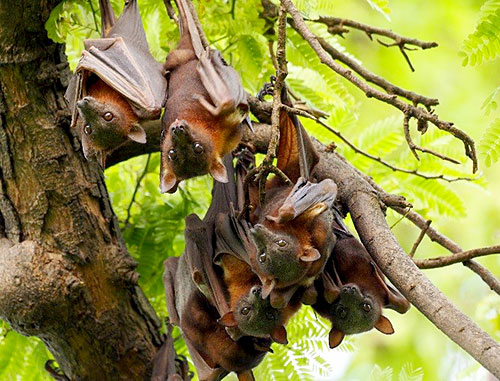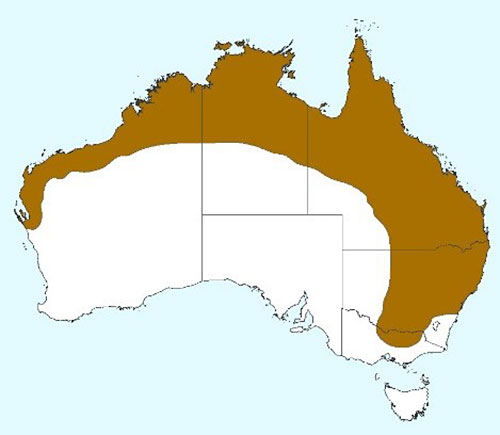North Queensland - Little Red Flying-Fox Roosts
Overview
The Alternative Management of Little Red Flying-Fox Roosts project involved scientific research and analysis on the ecology, behaviour and management of little red flying-foxes (Pteropus scapulatus). Its findings and recommendations will be used to improve flying-fox management in urban areas, particularly in north Queensland where little red flying-foxes travel huge distances across the landscape in pursuit of food from native plants, sometimes causing significant human-wildlife conflict when they arrive unexpectedly and in large numbers at populated locations.
The project is part of the Queensland Governments' $2.7 million Reduce Flying Fox Conflict Program, initiated to improve the management of problem urban flying-fox roosts in North Queensland.
The research component of the program, which was led by the Commonwealth Scientific and Industrial Research Organisation (CSIRO) in partnership with the department and other partners, is now complete and a comprehensive scientific report has been prepared for the department’s consideration. The department is currently working to summarise the findings from the report into guidance material that can be used by local governments and other land managers to better respond to and manage the impacts of flying-foxes at urban locations.

Queensland's flying-foxes and interactions with humans at urban roosts
Four flying-fox species, the black, grey-headed, little red and spectacled flying-fox, are commonly found in Queensland. All are protected under Queensland’s conservation laws. The spectacled flying-fox is also listed as endangered under Commonwealth environmental legislation and the grey-headed as vulnerable.
Little reds are the smallest of Queensland's flying-fox species, but they often form the largest colonies. Blossoms and nectar are their main food sources, and they frequently travel long distances each night to find them. When roosting in large numbers in urban areas, they can create significant noise, smell, droppings and tree damage, which can result in considerable community angst.
The majority of complaints about flying-foxes in urban areas arise from permanent flying-fox roosts and particularly those affected by large seasonal influxes of little red flying-foxes. At locations such as Charters Towers, the seasonal influx of up to tens of thousands of animals can result in animals moving beyond the boundaries of their traditional roosting sites into residential areas and creating conflict between flying-foxes and humans.
Most little red flying-fox complaints relate to the droppings, noise, smell and the perceived risk of disease near urban roosts.
Purpose of the project
The basic questions asked by the project were:
- How many little red flying-foxes are there?
- Where do they come from and go to?
- Why do they come and go?
- Why do they come to urban/peri-urban areas?
- What can we do to reduce conflict with humans?
What is known about little red flying-foxes
Little red flying-foxes are highly nomadic, following the seasonal flowering of eucalypts and melaleucas. Unlike other flying-fox species, little reds mostly eat native tree blossom and nectar as opposed to fruit. They may roost in large numbers – sometimes 100,000 or more – and typically stay 4 to 8 weeks in an area before moving on once the local food source has been exhausted. They are found right across northern Australia, and seasonally in New South Wales and Victoria (Figure 1).

In general we know very little about this species. Most of what we believe about their general behaviour and biology is based on studies of other flying-fox species. This is why this research in collaboration with CSIRO was so important.
The project
The department has worked with CSIRO to:
- Identify and monitor little red flying-fox roosts
- Describe their movement patterns
- Survey the distribution and dynamics of their food resources
- Identify the features of urban and other environments that attract flying-foxes
- Review the effectiveness of roost management methods.
As part of the research CSIRO scientists fitted little red flying-foxes with satellite transmitters to track their movements so we could better understand their movement across the landscape, their roosting preferences, and the factors that influence their roosting behaviour.
Most transmitters were fitted in Charters Towers in small batches over three years. Transmitters were attached to mature animals by a collar that designed to fall off after approximately three months. The collars and transmitters were successfully trialled for animal health and safety performance and their use for this project was given animal ethics committee approval.
In addition to identifying roosts and movement patterns, satellite telemetry has enabled the CSIRO to record and analyse when, where and what little reds feed on. This in turn has informed us about the relationship between major flowering events and movement patterns.
The project and other flying-fox monitoring in Queensland
Flying-fox monitoring is hampered by the unpredictable, widespread and nomadic nature of most flying-fox populations. To obtain more realistic population and location information for all species, Queensland along with other eastern Australian states, the Australian Government and the CSIRO, participate in the National Flying Fox Monitoring Program (NFFMP). The NFFMP coordinates consistent monitoring and reporting of a large proportion of flying-fox roosts nationally on a quarterly basis.
To learn more about little red flying-foxes read our living with seasonal flying-foxes fact sheet .
Log your interest in participating by emailing wildlife.management@des.qld.gov.au.
To learn more about the NFFMP data collection and mapping visit Monitoring Flying-Fox Populations.


